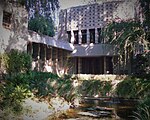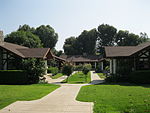Prospect Park, Pasadena, California
Prospect Park is a residential neighborhood in Pasadena, California. It is bordered by Westgate Street to the north, Orange Grove Boulevard to the south, Rosemont Avenue to the west, and Lincoln Avenue to the east. The original plan for the Prospect Park neighborhood was laid out in 1906, two years after J.C. Brainerd, Nyles Eaton, and John C. Bentz acquired the 32-acre parcel adjacent to a Los Angeles and Salt Lake Railroad spur. The land was divided into 64 lots along wide curved streets planted with camphor and palm trees. The area was filled in with architecturally distinctive homes by master architects, including Greene and Greene, during the 1910s and 20s.
Excerpt from the Wikipedia article Prospect Park, Pasadena, California (License: CC BY-SA 3.0, Authors).Prospect Park, Pasadena, California
Prospect Boulevard, Pasadena
Geographical coordinates (GPS) Address Nearby Places Show on map
Geographical coordinates (GPS)
| Latitude | Longitude |
|---|---|
| N 34.1548 ° | E -118.1599 ° |
Address
Prospect Boulevard 570
91103 Pasadena
California, United States
Open on Google Maps








